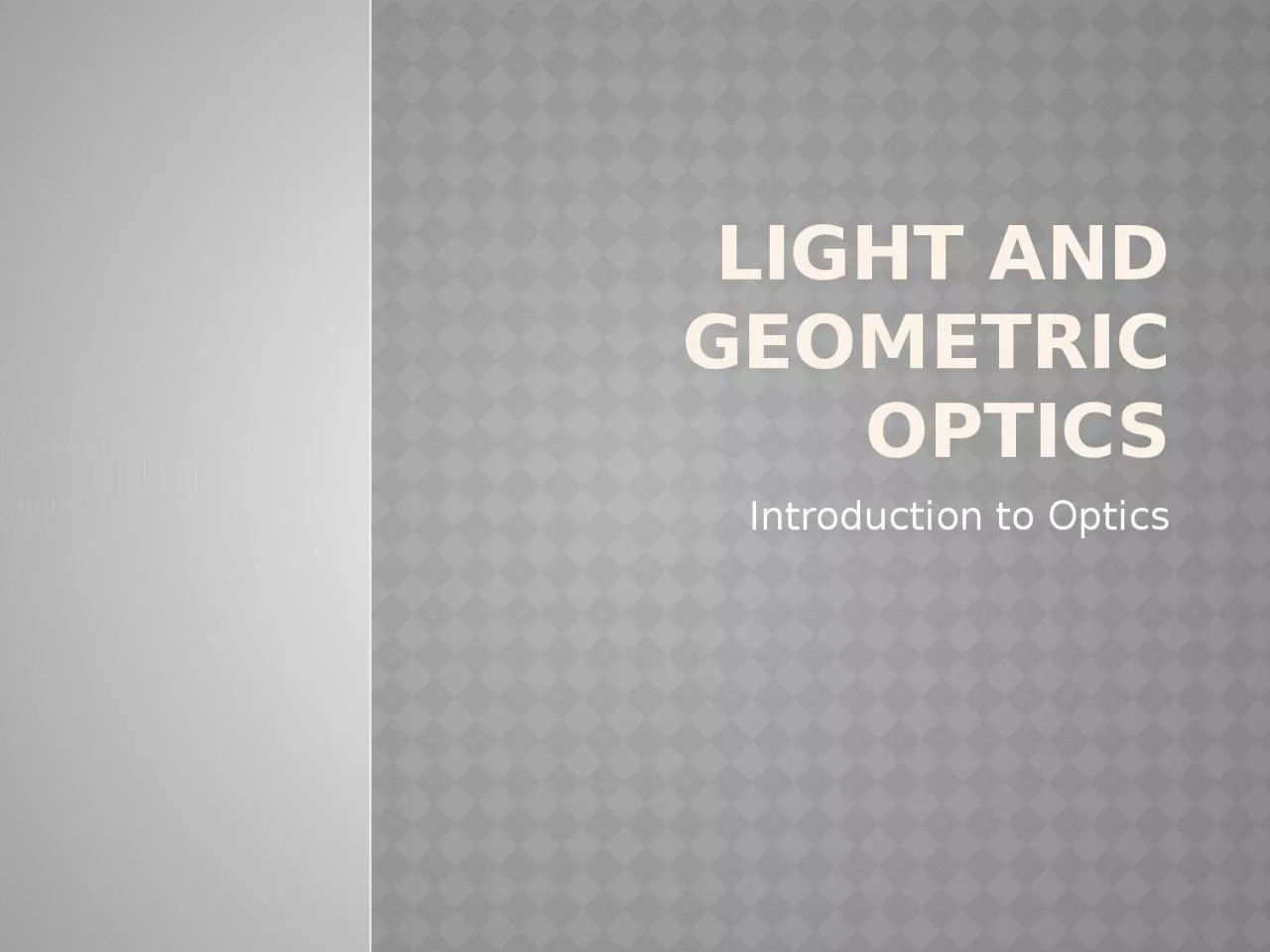

Introduction to Optics Overview The Great Debate What is light Properties of light The wavelike model Theories of colour Show me the light A historical debate Optics Optics is the study of the ID: 1031637
Download Presentation The PPT/PDF document "Light and Geometric Optics" is the property of its rightful owner. Permission is granted to download and print the materials on this web site for personal, non-commercial use only, and to display it on your personal computer provided you do not modify the materials and that you retain all copyright notices contained in the materials. By downloading content from our website, you accept the terms of this agreement.
1. Light and Geometric OpticsIntroduction to Optics
2. OverviewThe Great DebateWhat is light?Properties of lightThe wave-like modelTheories of colour
3. Show me the light!A historical debate:
4. OpticsOptics: is the study of the behaviour and properties of light
5. The wave model of lightLight: is a form of energy that travels in waves Wave: is a disturbance that transfers energy from one point to another without transferring matter We can use the properties of water waves to help us understand light waves (demonstration)We use waves on the surface of water to explain properties of light that we can see This is called a “model” a representation of an object, event or a process based on our observations of its characteristics and properties
6. terminologyCrest: Highest point in a waveTrough: Lowest point in a waveRest Position: Level of water when there is no wavesWavelength: distance from one place in a wave to the next similar place on the wave. The symbol for wavelength is λ (lambda) and is measured in meters. Amplitude: wave height from the rest position of the wave to the crest OR troughFrequency: rate of repetition of a wave. The frequency is measured in hertz (Hz) which is cycles per second.
7. Label the diagram:
8. Oh my… Math?!Relationship between Frequency and Wavelength ν= f λν= the speed of lightf= frequency f = 1/ λ λ = wavelength λ = 1/fThere is an inverse relationship between frequency and wavelength. When frequency increases, wavelength decreases, when wavelength increases, frequency decreases. How would energy relate?
9. What is light?Light is a form of energy. Light travels in packets of energy called photons. A photon is the smallest quantity of energy which can be transported. Photons travel with wave-like properties Properties of LightLight travels in straight lines (rectilinear propagation)Light does not need a medium to travel, it travels in a vacuum - empty space with no matterIn vacuum or air, speed of light is constant (c = 3.0 x 108 m/s)
10. The speed of light c = 3.0 x 108 m/s Speed = distance/time or If c = 3.0 x 108 m/s, then what is it in km/s? (300 000 km/s)EXAMPLE #1Calculate the time for light to travel from Toronto to Vancouver (d = 3400 km) c = 3.0 x 108 m/s EXAMPLE #2How long will it take for light to travel from the Moon to the Earth? (d = 400 000km) c = 3.0 x 108 m/s Example #3How long would it take a jet plane to travel this distance with the speed of 900 km/h, in days?
11. The electromagnetic spectrumThe light that we see is called visible light, and is only a fraction of the energy that surrounds us Electromagnetic radiation: wave pattern made of electrical and magnetic fields that can travel through empty space. The range is called electromagnetic spectrum
12.
13. Visible Light It is called visible light because that is the only part of the spectrum which our eyes have evolved to detect. The wavelengths of visible light range from 400-700 (micrometer – 10-6 of a meter) Only objects within that size range will absorb and reflect light of that wavelength.When light passes through a glass prism the light separates into the colours of the rainbow: Red Orange Yellow Green Blue VioletThis is called the visible spectrum
14. The wave model of light (again!)Colours of the visible spectrum have different wavelengths:Which colour has the longest λ, which has the shortest?ColourFrequency (Hz)Wavelength (nm)Red4.3 X10 14 700Orange5.0 X10 14600Yellow5.2 X10 14580Green5.7 X10 14550Blue6.4 X10 14450Violet7.5 X 10 14400
15. The colour yellow. Additive theoryAdditive colour theory: white light is composed of different colours of light. It is possible to produce white light by combining only three colours. RED + GREEN + BLUE = primary colours = white light 2 primary colours = secondary colour (cyan, yellow, magenta)
16. The Colour yellow: how do we see it?The subtractive colour theory of light: coloured matter selective absorbs different colours or wavelengths of light. The colours that are absorbed are subtracted from the reflected light that is seen by the eye.A black object absorbs all colours, white objects reflect all colours. Primary subtractive colours : cyan, magenta and yellow. Secondary subtractive colours are red, green, blue a blue object reflects blueand absorbs all other colours This theory applies to pigments and dyes
17. Producing Visible Light
18. Sources of light (omg, its chemistry again!)An electron orbiting the nucleus of an atom receives sufficient energy to jump to a higher orbital shell. When it loses energy and falls back to the lower shell the energy it releases escapes in the form of a photon, or particle of light (and you see LIGHT)
19. Sources of Light examplesIncandescence: is the emission of light from a hot body due to its temperature. Ex. Light bulb (filament is heated to high temperature and glows)Chemiluminescence: emission of light and heat as the result of a chemical reaction without a rise in temperature (called cool light). Ex. Glow sticks Bioluminescence: ability for plant and animals to produce light. Occurs in marine animals.
20. Ray Model of Light
21.